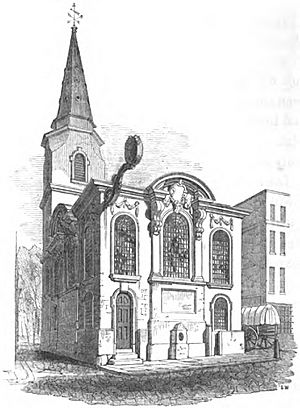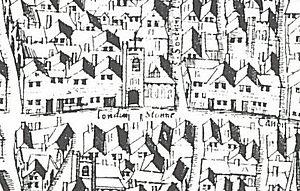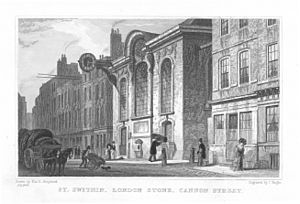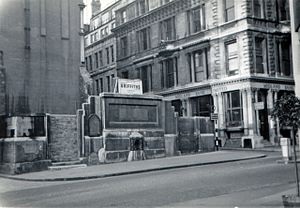St Swithin, London Stone facts for kids
Quick facts for kids St. Swithin, London Stone |
|
|---|---|

St Swithin's Church, with the London Stone housed at front beneath its central window
|
|
| Location | Cannon Street, London |
| Country | United Kingdom |
| Denomination | Church of England |
| Architecture | |
| Architect(s) | Christopher Wren |
| Style | Baroque |
| Closed | 1940 |
| Demolished | 1962 |
St Swithin, London Stone was an old Anglican church in the City of London. It was located on Cannon Street. The church was very old, dating back to the Middle Ages. It was sadly destroyed by the Great Fire of London in 1666. After the fire, it was rebuilt by the famous architect Sir Christopher Wren. Later, during the Second World War, the church was badly damaged by bombing. Its remains were taken down in 1962.
Contents
History of St Swithin's Church
The First Church Building
The church of St Swithin was first mentioned in records in the 1200s. It was named after Saint Swithin, who was a bishop in the 800s. At first, people called it "St Swithin in Candlewick Street." Candlewick Street was the old name for Cannon Street. By 1597, it became known as "St Swithin at London Stone." This name stuck because the famous London Stone was right across the street.
A Welsh Princess Buried Here
One interesting fact about the church is that it was the burial place of Catrin Glyndŵr. She was the wife of Edmund Mortimer and the daughter of Owain Glyndŵr. Owain Glyndŵr was a legendary Welsh leader who fought against the English.
Catrin was taken prisoner in 1409 when Harlech Castle was captured. She was held in the Tower of London. She died four years later in 1413. The only record of her death is a payment for her burial. It says: "for expenses and other charges incurred for the burial of the wife of Edmund Mortimer and her daughters, buried within St Swithin's Church London ... £1."
Changes Over Time
The church was rebuilt in 1420 by Sir John Hind. It was also repaired and updated in 1607–1608. Just before the Great Fire of London, it had another big renovation that cost £1,000.
The right to choose the church's priest, called the patronage, belonged to a priory (a type of monastery) in Sussex. This changed after King Henry VIII closed down the monasteries. The right to choose the priest then went to different owners. Eventually, the Salters Company bought it.
Rebuilding After the Great Fire

The church was completely destroyed in the Great Fire of London in 1666. It was then rebuilt by Sir Christopher Wren in 1678. The cost was about £4,687. The nearby church of St Mary Bothaw was also destroyed but not rebuilt. Its parish (area) was joined with St Swithin's.
The new church was 61 feet long and 42 feet wide. It had a tall tower and a spire (a pointy top) that reached about 150 feet high. This tower was at the north-west corner of the building.
Inside, the church had a main area and an aisle (a side section) with a gallery. Most of the church was covered by a round, dome-shaped roof. An organ was added to the church in 1805.
Later Years and Demolition
London Stone's New Home
In 1742, the famous London Stone was moved. It had been on the south side of the street. It was moved to stand next to the church door. In the 1820s, it was placed inside a special stone space in the church's south wall. It stayed there until the church was torn down in 1962.
Repairs and Changes
Around 1820, the church had more repairs. In 1869, there were more changes inside. The seats were changed to face the east. Galleries were removed, and the pulpit was made lower. A large brass light fixture that hung from the dome was also taken down. In 1879, the front part of the church was updated.
Damage and Demolition
In 1940, during the Second World War, the church was badly damaged. An air raid hit it. Only the pulpit was saved. This pulpit is now in another church called All Hallows by the Tower.
The church was not rebuilt after the war. In 1954, its parish was joined with St Stephen Walbrook. The land where the church stood was sold in 1960. The ruined church was finally torn down in 1961–1962.
What Was Found Underground
After the church was demolished, people dug up the site to learn about its past. They found parts of a Roman street that was on the same line as Cannon Street. They also found timber and stone buildings from Roman times.
They discovered the foundations of the church built in the early 1400s, beneath Wren's church. This medieval church was a bit smaller. It had a main area and side aisles. Underneath that, they found hints of an even older church from the 1100s.
A medieval grave slab was also found. It was made of Purbeck marble. The writing on it showed it was for Joanna, the wife of Fulke de St Edmond. He was one of the sheriffs of the City of London in 1289–1290. This slab is now in the Museum of London.
Today's Site
Today, the London Stone is in front of a new building at 111 Cannon Street. The old churchyard is now a public garden. It was updated in 2010. There is a special memorial in the garden for Catrin Glyndwr. It also remembers all women and children who suffer in wars.
Burials at St Swithin's
- Catrin ferch Owain Glyndŵr and three of her daughters
- Ralph Josselyn, a Lord Mayor of London in 1464 and 1476
Images for kids
-
St Swithin's Church, with the London Stone housed at front beneath its central window
-
St Swithin's Church and London Stone on an old map from the 1550s.







